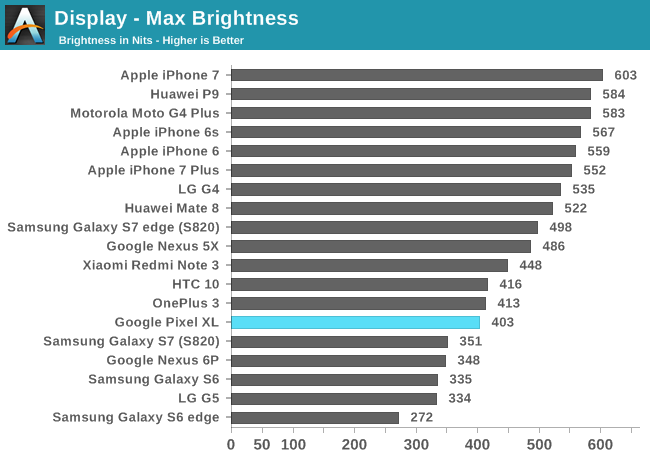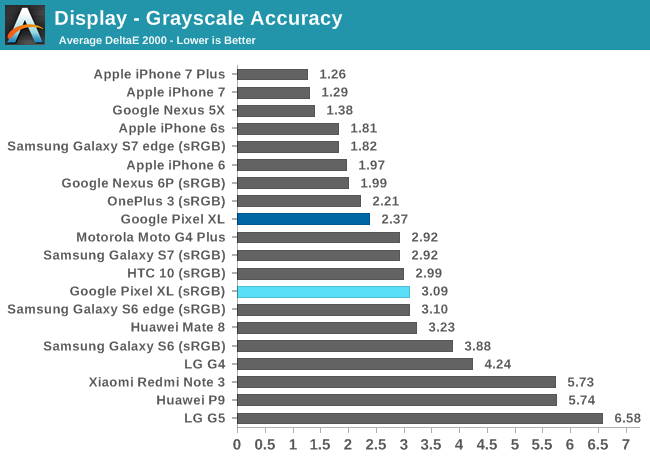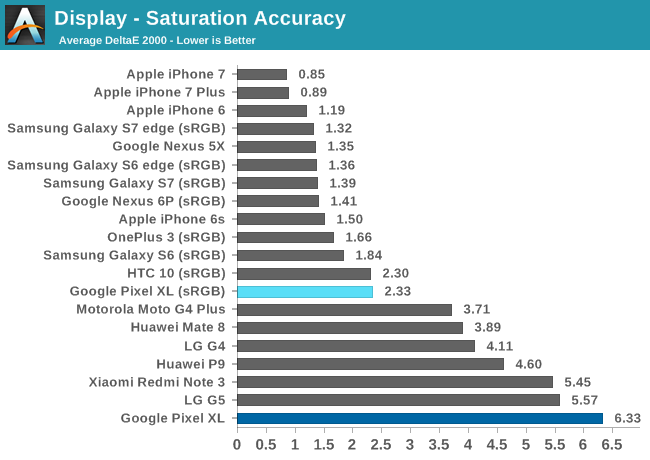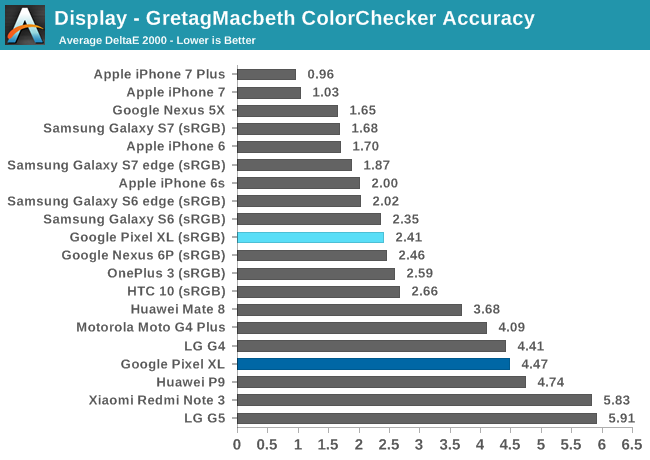The Google Pixel XL Review: Life After Nexus
by Matt Humrick & Brandon Chester on November 8, 2016 8:00 AM EST- Posted in
- Smartphones
- Mobile
- Snapdragon 821
- Pixel
Display Analysis
Section by Brandon Chester
Google was one of the first companies to deploy AMOLED displays in their smartphones. While they were made by partner companies, the Nexus One, Nexus S, and Galaxy Nexus all used AMOLED displays. The Nexus One actually shifted to LCD midway through its lifetime, although it was mostly due to supply issues rather than concerns about quality. When the production of Nexus smartphones was taken over by LG during the time of the Nexus 4 and 5, the devices moved to LCD displays. From a cost perspective this made a great deal of sense, as those devices were all very aggresively priced and using LCD displays helped in bringing down costs. With the Nexus 6 Google went back to AMOLED again, and for the Nexus 5X and 6P there was a split between LCD on the 5X, which was made by LG, and AMOLED on the 6P, which was made by Huawei.
With the Pixel and Pixel XL being the first phones being branded as purely Google, the choice of display technology is a good indicator of where Google feels the market is headed. In this case there's no need to make any concessions to drive down price, and because of that, Google has decided to go all in on AMOLED. The smaller Pixel has a 5.0" AMOLED display with a resolution of 1920x1080. The larger Pixel XL that I'll be examining here is a 5.5" 2560x1440 AMOLED display. These are the same specs as Samsung's Galaxy S7 Edge minus the curved edges, so that will be an interesting point of comparison.
Both models of the Pixel have a sufficiently high resolution, and I think it's worth stating again that opting to go with a 1080p display on a 5.5" phone is the wrong decision if you're shipping a PenTile AMOLED display, because your chroma resolution is reduced. Google has definitely made the correct decision in that regard by going with 1080p on the smaller model, but moving to 1440p on the larger one.
Meanwhile, as smartphone manufacturers are starting to look at wider color gamuts, Google is no exception. Both versions of the Pixel ship with an AMOLED display that (oddly) supports the NTSC gamut, and defaults to using that gamut. We'll get into the guts of how this works and the tradeoffs involved, but importantly, the phones also support being put in the more standard sRGB mode, which clamps the gamut to the afformentioned standard. This adds another facet to our testing, especially given the pros and cons of using the different gamuts.
Ultimately a display has many factors beyond resolution, and evaluating displays in an objective manner requires each of these properties to be measured and compared to a common standard. In this case, we use the sRGB standard which is the standard color space for all content on the web, and for essentially all computers in general at this time. Measurements are taken using an X-Rite i1Pro 2 spectrophotometer and compiled in SpectraCal's CalMAN 5 software.

The Pixel XL's peak brightness is on the lower side, topping out at 403 nits. This is higher than the Nexus 6P, but not as high as the best we've seen from AMOLEDs on Samsung devices where the displays can reach nearly 500 nits in manual mode. Competing LCDs can go even brighter, with many being able to sustain a manual brightness of 550 to 600 nits indefinitely.
The larger issue here is that Google provides no boost mode when the phone is set to automatic brightness. Samsung does this on their AMOLED devices, and other vendors have begun to offer the same sort of feature on LCD displays. This means that in bright ambient lighting, other devices will reach anywhere from 600 to 800 nits in order to maximize visibility, while the Pixel XL will remain at 403 nits. The OnePlus 3 is another example of a recent AMOLED device without a boost mode, and at $399 I considered it acceptable, but with the Pixel XL's starting price of $769 I really don't know what Google's excuse is for being so far behind the competition here.
While the Pixel XL doesn't fare well when you look at its brightness, the use of AMOLED displays means that you get perfect black levels and an essentially infinite contrast, although one does have to consider that reflections from ambient light generally prevent that theoretical contrast ratio from being realized in practice. Even so, when put next to a standard LCD the Pixel XL's black levels make the LCD's deepest possible blacks look like light grey in comparison.

The greyscale situation on the Pixel XL is actually quite interesting. In both cases Google has a relatively straight gamma, but the default NTSC color mode is slightly blue-shifted, while the sRGB mode is lacking in blue, and actually shifted a bit toward green. The overall error level is lower in the NTSC mode, and I would agree that skewing toward blue is better visually than skewing toward red, particularly because human vision is least sensitive to blue.
The issue here is that the sRGB color mode will provide more accurate colors, but a less accurate greyscale. While you can't tell from the correlated color temperature average alone, if you look at the RGB balance for each greyscale shade in the sRGB mode you'll see that it's shifted toward red, but it also has too much contribution from the green component as well. Even slight skewing toward green has a profound impact on the appearance of greyscale shades, and I find the greyscale reproduction in the sRGB mode is very unpleasant. With the OnePlus 3 side by side it's clear that they're both warmer than the target of D65, but the OnePlus 3 is still looks like white, while the green-shifted Pixel XL looks quite ghastly. Having the bulk of your error come from hue and chrominance instead of luminance is not a good way to go, and I'd say that the Pixel XL misses the mark on greyscale accuracy in its sRGB mode.

The NTSC color mode is just a disaster for saturation accuracy, although it's that way by design. Targeting a wide gamut is the wrong way to go on Android because the OS is not color aware, but if a company feels the need to offer a wide gamut mode it should at least be a gamut that is actually used for consumer content instead of an ancient, irrelevant gamut from the days of analog television. What really shocks me is how Google has gone so far backward from the days of the Nexus 5 and Nexus 7 (2013) where its devices were shining examples of how to make a mobile device with a great display.
Thankfully, the sRGB mode is quite accurate, although heavy competition in the smartphone market means that it's still in the bottom half of the chart despite its accuracy. The only thing you could really complain about is that blues are a bit farther off than they should be, and 100% saturations for red, blue, and green fall a bit short as well. This is just nitpicking though, and I don't think anyone will have an issue with the accuracy of primary and secondary colors when using the sRGB mode.

The GretagMacbeth ColorChecker follows the same trend as the saturation test. In the NTSC color mode the error is relatively high, with many colors actually falling outside the sRGB gamut. Not surprisingly, chrominance errors constitute the largest portion of the overall error for each color mixture. The sRGB mode brings the errors under control, and the only colors where the error is a bit concerning are the blue shades, which makes sense given that the greyscale is deficient in blue which leads to the issues in rendering pure blues of varying saturation, as well as color mixtures with significant blue color components. One again, despite the good level of accuracy, the Pixel XL is actually just in the middle of the chart due to many devices with exceptional accuracy shipping in recent times.
The AMOLED display on the Pixel XL is a very high quality panel. I would say it's at least as good as the Nexus 6P, and further investigation into power usage may show that it's actually improved in that regard due to improvements in emitter efficiency in the past year. As far as color accuracy goes, both color modes have their own issues. The NTSC color mode is clearly not going to have a good level of color accuracy relative to the sRGB standard, which makes sense given that the gamut has completely different chromaticity values. I would like to reiterate that nobody who actually understands color and the color standards used today would ever choose the NTSC gamut, and I'd really love to know if it was actually something Google decided or if this is just how panels are coming from AMOLED suppliers.
The sRGB mode is very good for color accuracy, although as I mentioned earlier, being really good as far as an objective analysis goes now means your accuracy is just decent relative to the competition. Realistically, I think the color accuracy on the Pixel XL is more than sufficient for any users. The only issue is that the greyscale exhibits significant green shifting. This is a big problem, and it's enough to make the sRGB mode unpleasant to use because the white background of the app drawer, apps, and web pages has a sickly green hue. The NTSC mode is skewed toward blue, but it's much less distracting than the sRGB mode's skew toward green.
Unfortunately, using the NTSC mode means you have to deal with inaccurate colors. For me, both color modes have at least one significant problem that negatively impacts my experience as a user. It's enough of a problem that I don't enjoy the Pixel XL's display because I'm used to devices like the OnePlus 3 and iPhone 7 which have accurate greyscale and color rendering. I believe that I'm more sensitive to this than most users because I'm coming from devices that are very close to the sRGB standard so I have that point of reference. Even so, as far as an objective display evaluation goes, I'd have to say that the Pixel XL has a very high quality display, but neither color mode is quite as good as what you can find on competing devices, including some that cost significantly less than the Pixel XL.










250 Comments
View All Comments
andrewaggb - Wednesday, November 16, 2016 - link
Went phone shopping this past weekend. Everybody was pushing the Pixel pretty hard but honestly I didn't like it.Samsung has better screen to body ratio's and I dislike the virtual home button. Open chrome and it takes up a chunk of the screen, on the samsung phones you get text in that area instead. Cameras and screen weren't any better than samsung's either. I'd take an s7 edge over the pixel anyday.
But I was pleasantly suprised by the LG V20. Unfortunately the only carrier I could find it on doesn't have coverage in my area but the phone itself was pretty nice. Really wide angle selfie-cam (wider fov than my note 5 which already has a wider fov than most phones), nice large screen (that looked good, unlike the g5 that I think has a terrible screen), and the extra 2nd screen at the top for music controls/wifi/clock etc is a nice little touch as well.
ithehappy - Thursday, November 17, 2016 - link
This is pretty ridiculous! They are charging same as iPhone and S7E, but they don't give you a great display? Or like you mentioned, the camera even, which is Pixel's main selling point, S7 outperforms it in low light? What the heck is this? I wanted to buy this phone when it cooled down in price a bit, but especially after reading the Display section I think I am out! If OnePlus 3's display is better (more accurate is better in my dictionary) then I would simply go for it, it costs like 70% less too! Jeez!That display completely putting me off from this. Really sad.
syrious - Friday, December 16, 2016 - link
Yea, you'd be better off with the OnePlus 3 or waiting for a S8, the displays on the sammy phones are phenomenal.AMD718 - Sunday, November 20, 2016 - link
Reading through the comments, it's apparent to me that you have both Nexus/Pixel advocates and haters. The haters, as expected, are thoroughly delighted by this review as it plays to their confirmation bias. At the same time, the advocates are disheartened because it allows them no confirmation bias. But, let's be honest - The authors are biased as well. This isn't a cut on the authors. It's merely recognition that they are, in fact, human beings and not technology-reviewing robots impervious that remain 100% objective at all times. So, there is subjectivity in this article and people would be well-served in reading many reviews when they are looking for a new device. As an example, the TechSpot Pixel XL review (google it, not putting the link here) rates the Pixel XL's dispaly in sRGB mode as excellent -"... in my testing with the Pixel XL in its sRGB mode, this display is the most accurate I have seen. In my punishing custom CALMAN 5 accuracy test, the Pixel XL recorded an astonishing dE2000 value of 1.18, which indicates near-perfect color performance. The Pixel XL also reported near-perfect grayscale accuracy and spot-on gamma."
Similarly, other reviews offer drastically different assessments of the camera relative to the competition.
Bottom line, look at this review as one of many resources that you can draw upon to make your own conclusion. AnandTech's review is certainly professional and high-quality, but it is not the end-all-be-all.
ithehappy - Sunday, November 20, 2016 - link
Damn! I never heard about this Techspot, but will surely read their review. I really don't know how there could be this massive difference in calibration results when same tool is used, there can't be a human error, so I don't know what to say really!Androider - Sunday, November 27, 2016 - link
The launcher being evicted from memory is a familiar phenomenon for any Nexus user when you push the device. Happens on my Nexus 7, 5 and 6p. You get a completely black screen for maybe 3-6 seconds while the launcher is either restarted or swapped in. I have no doubt it would happen on the Pixel unless Google has rearchitected the whole thing, which they clearly haven't.This is exactly the type of thing you won't find in a few days of testing, but will run into after using the phone for weeks and months. Thank you Anandtech for a thorough, and honest review! Android has a lot going for it, and it is my platform of choice, but you have to be honest about its shortcomings.
lokesh - Wednesday, November 30, 2016 - link
I don't agree because still i vote for iPhone 7 than Google Pixel XL. In iphone i can download paid apps with vshare app but i don't know how to download paid apps for free in Google Pixel XL. http://www.vshareappdownloads.com/Zovuvazz - Wednesday, November 30, 2016 - link
I recently purchased a Pixel and have three things to say about it:1. It is the first Android phone I've ever owned about which I have no complaints. Everything about it works perfectly. It reminds me of iPhones, to some degree, in how polished the interface looks, feels, and works.
2. The bezel at the bottom is quite useful as an area of the phone in which touching it doesn't accidentally cause something to happen.
3. Its design is "boring"? Only to attention whores, perhaps.
syrious - Friday, December 16, 2016 - link
FINALLY a true review of the Google Pixel phones, people over hype this phone so much. TBH I think its absolute garbage and isn't ready to compete with Sammy or Apple.I mean the phone isn't even waterproof, how are you making a device that isn't water resistant in 2016?
eh_ch - Sunday, January 1, 2017 - link
This review is lies, the Pixel rocks.Crazy fast, smooth scrolling, camera is incredible and this review stole a month of enjoyment of my Pixel from me. I
hemmed and hawed, and then it was out of stock, so it was another week before it was available again, and then another three weeks to ship.
Anandtech I love your articles, but the criticisms of Apple fanboyism are ABSOLUTELY correct.